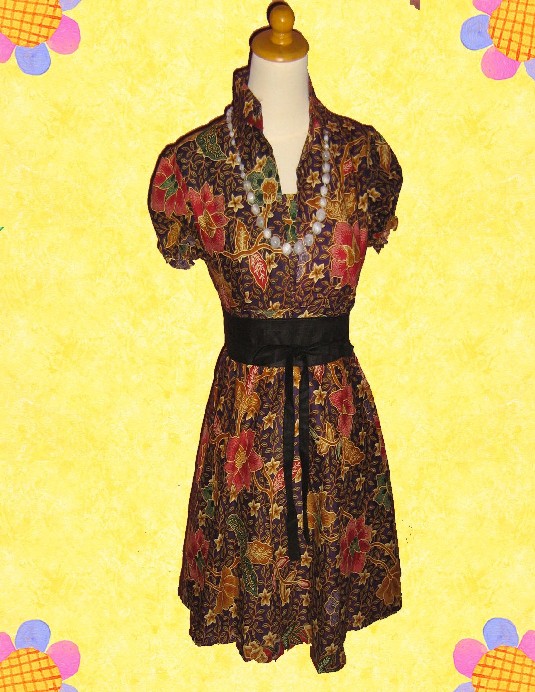| KainBatik.com |
| GROSIR ANEKA SENI BATIK INDONESIA |
Archive for the ‘gaun’ Category
Ancient Art Of Batik In The Modern World
Saturday, February 21st, 2009With the recent economic “waking up” of global emerging markets, it would only be logical that other social segments of such markets would enjoy a revival of sort as well, and art forms of many kinds are no exception to this new found revival.
An artist from such an emerging market is Rita and she creates within an art form which is some 2000 years old and has been practiced in our western hemisphere only sparingly, partially due to its complexity, very time consuming and hot, messy application during the process of creating this art. Most everyone is familiar with this art when associated with linen and clothing, but less knowledgeable as to hanging wall art and framed work.
The art form I am referring to is BATIK. The art of Batik has several styles and forms and in accordance to global regions of their origin. There is the Chinese Batik, African Batik, Ukraine Batik and Batik styles from the Americas and the Caribbean Island. All have the same basis and use the same or similar materials in connection with this art, but it’s the application process and its higher complexity of such application, which differs the regional labeling. The most detailed and resolution wise (at least in my humble opinion) the most beautiful Batik art form, is the not yet mentioned Java Batik, the form of Batik Art which I create and have been for some 30 years. The extra efforts, details and time consumption applied to this style of Batik Art is indisputably recognized by its final outcome of colors so vibrant and details of work so prevalent, the viewer could easily see it as “alive” if not at least visually most penetrating.
Perhaps this would be the right moment to describe this elusive art form and its method of application, and from experiences on the art show circle, I have encountered that even judges in juried competition have very limited knowledge as to the methods applied and efforts behind this form of art. However, whenever I’d invite such judges into my booth and made a presentation as to the creation of Batik Art, I did end up with an award for my art work. I believe creating art is more than just the outcome of such creation but some emphasizes should be given as to how the artist is getting there.
The word “batik” is roughly translated as “wax painting”. As an art painter takes his brush of colors to create, a batik artist draws with the wax as to protect area from a certain color during the dye dip process. Batik is done on either silk or cotton, although the Java style of batik is mostly on cotton. Cotton, with its smooth and tight texture translates into higher resolution than the much looser and lighter silk fabric. Due to the process and method of batik, an authentic batik can be viewed on either side of the fabric, thus many batik arts are mounted between glass and matted as to show both sides, thus Two Arts in One.
The batik artist, after the original pencil drawing onto the fabric, be it cotton or silk, uses a “canting’ tool to trace in details what the pencil drawing shows. The “canting” tool (imagine a small handheld funnel) is filled with a certain mixture of wax (Bee/Paraffin) and kept at a certain temperature as to keep it in liquid form, but still pasty. This wax will be applied to the fabric and its proper temperature will allow it to penetrate the fabric. The wax, upon drying will seal the fabric beneath it, just like a cocoon. The artist having covered all area of the Batik with wax BUT with EXCEPTION for area to which a chosen color will be allowed, will actually dip the fabric with the applied wax and all, into the color dye chosen for the area not covered with the protective wax. In most cases the artist would start with the lighter colors. After this several minute of Dye bath, the fabric is pulled and hung to drip and dry. Once the just applied color is totally dry, the artist will boil the fabric as to remove the wax entirely from the fabric. By the way, the removed wax is subsequently scooped up from the water, as it floats, and recycled into further use. The second step is to repeat the first step and so forth and for each layer of color designated for the Batik in creation. During the washing cycle of the dyed fabric a secret solution of salt and other chemical in a cold bath is applied as well during each process. This method of secrecy brings out the vibrancy of the colors.
In review and analyzing of the above description of the process to create such art work, one can quickly understand the complexity, pain striking details as well as the rather hot and uncomfortable environment the artist exposes him/herself to. The clean up process has its own challenges as well, of course.
An authentic batik is always and only an original, as the working with liquid wax on fabric will NEVER leave the exact duplicate like a print would, even if the design of the art is repeated on a second batik. The logic there should be obvious.
Although the above description of the method and process to create Batik Art, it was kept very simple, as the actual complexity is heighten by the artist knowledge of mixing dyes to achieve certain special colors, as well as crackling effect in certain batik pieces and how it is achieved by the artist. A more in-depth presentation can only be given when Batik sample is shown in association thereto.



